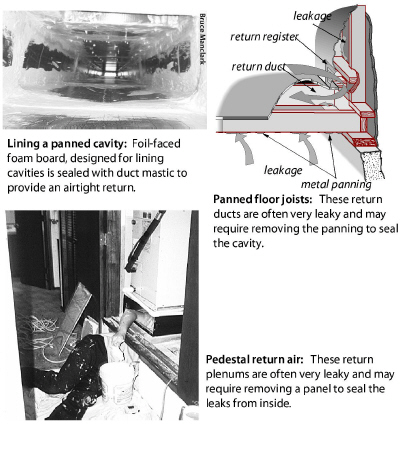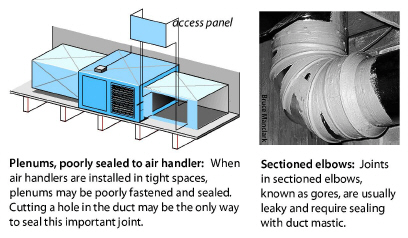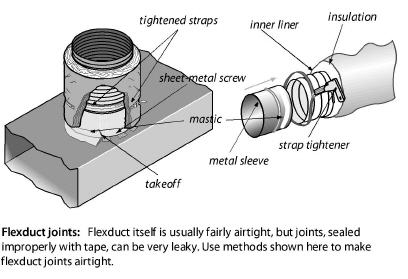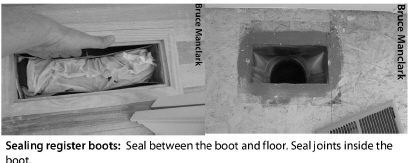
Ducts located outside the thermal boundary or in an intermediate zone like a ventilated attic or crawl space should be sealed. The following is a list of duct leak locations in order of their relative importance. Leaks nearer to the air handler are exposed to higher pressure and are more important than leaks further away.
8.15.1 General Duct-Sealing Methods
Duct sealers install duct mastic and fiberglass mesh to seal duct leaks. When they need reinforcement or temporary closure, the duct sealers use tape or sheet metal. Observe these three standards.
1. Seal seams, cracks, joints, and holes, less than ¼ inch using mastic and fiberglass mesh.
2. Bridge seams, cracks, joints, holes, and penetrations, between ¼ and ¾ inch, with sheet metal or tape and then cover the metal or tape completely with mastic reinforced by mesh at seams in the sheet metal or tape.
3. Overlap the mastic and mesh at least one inch beyond the seams, repairs, and reinforced areas of the ducts.
Return leaks are important for combustion safety and for efficiency. Use the following techniques to seal return ducts.
✓ First, seal all return leaks within the combustion zone to prevent this leakage from depressurizing the combustion zone and causing backdrafting.
✓ Seal all return ducts in crawl spaces for indoor air quality.
✓ Seal panned return ducts using mastic to seal all cracks and gaps within the return duct and register.
✓ Seal leaky joints between building materials composing cavity return ducts, like panned floor cavities and furnace return platforms. Remove the panning to seal cavities containing joints in building materials.
✓ Carefully examine and seal leaks at transitions between panned floor joists and metal trunks that change the direction of the return ducts. You may need a mirror to find some of the biggest return duct leaks in these areas.
✓ Seal filter slots with a tight-fitting, durable, user-friendly filter-slot cover to allow easy removal for filter-changing.
✓ Seal the joint between the furnace and return plenum with silicone caulking or foil tape.

|
SWS Detail: 3.1602.1 Air Sealing Duct System, 3.1602.5 Return—Framed Platform, 3.1602.4 Air Sealing System Components, 3.1601.8 Preparation and Mechanical Fastening—Mid and High Rise, 3.1602.7 Return and Supply Plenums in Basements and Crawl Spaces, 3.1601.3 Support |
Inspect these places in the duct system and seal them as needed as required by MN WAP policy.
✓ Plenum joint at air handler: Technicians might have had problems sealing these joints because of a lack of space. Seal these plenum connections thoroughly even if you must cut an access hole in the plenum.

✓ Joints at branch takeoffs: Seal these important joints with a thick layer of mastic. Fabric mesh tape should cover gaps and reinforce the seal at gaps.
✓ Joints in sectioned elbows: Known as gores, these are usually leaky and benefit from sealing with duct mastic.
✓ Tabbed sleeves: Attach the sleeve to the main duct with 3-to-5 screws and apply mastic plentifully. Or better, remove the tabbed sleeve and replace it with a manufactured takeoff.
✓ Flexduct-to-metal joints: Apply a 2-inch band of mastic to the end of the metal connector. Attach the flexduct’s inner liner with a plastic strap, tightening it with a strap tensioner. Attach the insulation and outer liner with another strap.
✓ Damaged flex duct: Replace flex duct when it is punctured, deteriorated, or otherwise damaged.
✓ Deteriorating ductboard facing: Replace ductboard, preferably with metal ducting, when the facing deteriorates because this deterioration leads to a lot of air leakage.

✓ Consider closing supply and return registers in unoccupied basements or crawl spaces.
✓ Seal penetrations made by wires or pipes traveling through ducts.
✓ Seal the joint between the boot and the ceiling, wall, or floor between conditioned and unconditioned areas.
Duct Support
✓ Support rigid ducts and duct joints with duct hangers at least every 5 feet or as necessary to prevent sagging of more than one-half inch.
✓ Support flexible ducts and duct board every 4 feet using a minimum of 1 ½" wide support material.

8.15.4 Materials for Duct Sealing
Duct mastic is the best duct-sealing material because of its superior durability and adhesion. Apply mastic at least 1/16-inch thick, and use reinforcing mesh for all joints wider than 1/8-inch or joints that may move. Install screws to prevent joint movement or separation.
Aluminum foil or cloth duct tape aren’t good materials for duct sealing because their adhesive often fails. Consider covering tape with mastic to prevent tape’s adhesive from drying out and failing.